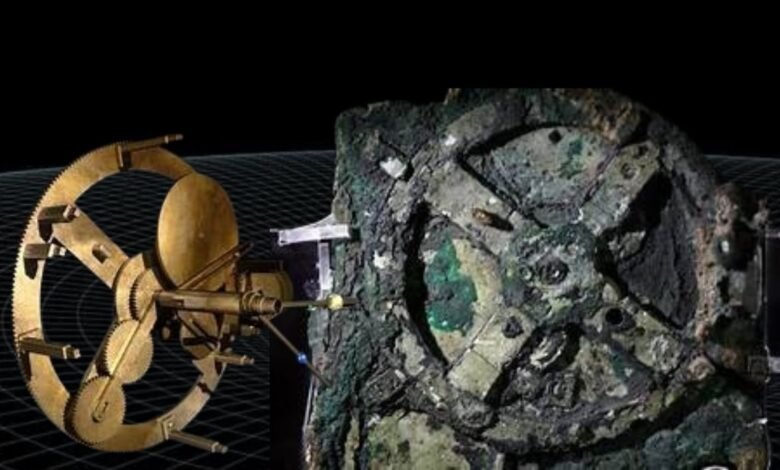Antikythera Mechanism (2024): New Insights from Gravitational Wave Research
Antikythera Mechanism (2024): Discover new insights from gravitational wave research in this groundbreaking study.

Antikythera Mechanism, an ancient Greek analog computer, is a marvel of early engineering and astronomical knowledge. Discovered in 1901 by sponge divers off the coast of the Greek island of Antikythera, this intricate device has captivated scientists and historians alike for over a century. Its primary function was to predict astronomical positions and eclipses, a testament to the advanced understanding of celestial mechanics possessed by the ancient Greeks.
Encased in a corroded, bronze shell, Antikythera Mechanism was initially dismissed as a simple artifact. However, subsequent investigations revealed its true complexity. The device consists of a series of interlocking gears and dials, meticulously crafted to replicate the movements of celestial bodies. This mechanism could track the cycles of the Moon and Sun, predict solar and lunar eclipses, and even model the irregular orbit of the Moon, known as the lunar anomaly.
The historical significance of the Antikythera Mechanism cannot be overstated. It represents the earliest known example of a sophisticated mechanical computer, predating similar devices by more than a millennium. Its discovery has provided invaluable insights into the technological capabilities of the ancient Greeks, challenging previously held notions about the development of scientific instruments.
Over the years, the Antikythera Mechanism has been the subject of extensive research and analysis. Advances in imaging technology, such as X-ray computed tomography, have allowed researchers to peer inside the corroded remains, revealing previously hidden details and shedding light on its construction and operation. These efforts have not only deepened our understanding of this remarkable device but have also sparked renewed interest in the study of ancient technologies.
As we continue to uncover more about the Antikythera Mechanism, it serves as a powerful reminder of the ingenuity and scientific prowess of ancient civilizations. Its enduring legacy continues to inspire and intrigue, offering a glimpse into a world where the boundaries of knowledge were constantly being pushed and expanded.
The Mystery Behind the Antikythera Mechanism
Antikythera Mechanism has long been a source of fascination and intrigue for historians, archaeologists, and scientists alike. Discovered in a shipwreck off the coast of the Greek island Antikythera in 1901, this ancient artifact has been dated to around 100 BCE. Its sophisticated design and intricate gear system have baffled researchers, leading to a plethora of theories regarding its origins and purpose.
At its core, the Antikythera Mechanism is an ancient analog computer, used to predict astronomical positions and eclipses for calendrical and astrological purposes. The level of technological advancement observed in this device is extraordinary, considering its era. Featuring over 30 meshing bronze gears, the mechanism’s complexity suggests a highly advanced understanding of both engineering and astronomy that was previously unassociated with the ancient Greeks.
Various theories have been proposed to explain the origins and function of the Antikythera Mechanism. Some researchers believe it was designed by a team of scientists, possibly influenced by earlier Babylonian or Egyptian knowledge. Others speculate it might have been created by a single genius, such as Archimedes, known for his profound contributions to mathematics and engineering. Despite these theories, concrete evidence remains elusive, leaving significant gaps in our understanding.
Further complicating the mystery, the purpose of the Antikythera Mechanism has been debated extensively. While the prevailing view is that it served an astronomical function, some suggest it could have been used for navigation or even as a teaching tool. Each new discovery only deepens the mystery, as the more we learn, the more questions arise about the true extent of ancient Greek technological prowess.
Antikythera Mechanism continues to challenge our perceptions of ancient technology. Its intricate design and advanced functionality prompt us to reconsider the technological capabilities of ancient civilizations, highlighting the many gaps that still exist in our understanding of this enigmatic device.
Gravitational Waves: A Brief Overview
Gravitational waves are ripples in the fabric of space-time, generated by the acceleration of massive objects, such as merging black holes or neutron stars. These waves propagate outward at the speed of light, carrying with them invaluable information about their cataclysmic origins and the nature of gravity itself. The existence of gravitational waves was first predicted by Albert Einstein’s General Theory of Relativity in 1915, but it wasn’t until a century later that their presence was definitively confirmed.
The groundbreaking discovery came in 2015, when the Laser Interferometer Gravitational-Wave Observatory (LIGO) detected gravitational waves for the first time. This historic observation verified Einstein’s century-old prediction and marked the dawn of a new era in astrophysics. The detection was achieved using highly sensitive laser interferometers, which measure the minute distortions in space-time caused by passing gravitational waves. These distortions are astonishingly small, often less than a thousandth the diameter of a proton, requiring extremely precise and sophisticated technology to observe.
Research into gravitational waves has since expanded our understanding of the universe in remarkable ways. By analyzing the data from these waves, scientists can infer details about the events that generated them, such as the mass, spin, and distance of merging black holes or neutron stars. This new method of observation complements traditional electromagnetic astronomy, offering a novel and powerful tool to probe the cosmos. Gravitational wave research has unearthed insights into the behavior of matter under extreme conditions, the population of stellar-mass black holes, and the rate of expansion of the universe.
The continuous advancements in gravitational wave detection technology promise even more profound discoveries in the future. As we refine our techniques and increase the sensitivity of our instruments, we can expect to uncover further secrets of the universe, enhancing our comprehension of its fundamental workings.
How Gravitational Wave Research Sheds Light on the Mechanism
Recent advancements in gravitational wave research have significantly contributed to our understanding of the Antikythera Mechanism. Gravitational waves, ripples in space-time caused by massive celestial events, have become a crucial tool in modern astrophysics. Their detection and analysis provide invaluable data, allowing scientists to uncover hidden aspects of the universe. This profound knowledge is now being applied to decode the enigmatic functions and origins of the Antikythera Mechanism.
One of the pivotal studies bridging these two fields involves the precise measurement of gravitational waves, which has led to the development of highly sophisticated computational models. These models have been instrumental in simulating the celestial events that the Antikythera Mechanism was designed to predict. By understanding the mechanics behind these waves, researchers can reconstruct the ancient device’s purpose with unprecedented accuracy.
Technological advances in sensor and detector equipment have also played a significant role. Instruments like the Laser Interferometer Gravitational-Wave Observatory (LIGO) have provided high-resolution data that can be cross-referenced with the mechanical functions of the Antikythera Mechanism. This data helps to refine our understanding of how the device’s gears and dials translate complex astronomical phenomena into comprehensible predictions.
Moreover, the study of gravitational waves has enhanced our grasp of celestial mechanics, revealing intricate details about planetary movements and stellar cycles. This deeper understanding of the universe’s gravitational interactions is crucial for decoding the Antikythera Mechanism, which is essentially a miniature model of these cosmic events. By leveraging insights from gravitational wave research, scientists are beginning to unlock the secrets of this ancient computational device, shedding light on its intricate design and sophisticated astronomical calculations.
In essence, the convergence of gravitational wave research and the study of the Antikythera Mechanism exemplifies how modern science can illuminate ancient technology. The ongoing research continues to reveal the profound interconnectedness of our universe and the timeless ingenuity of human invention.
Key Discoveries in 2024
The year 2024 has been monumental for the study of the Antikythera Mechanism, primarily due to advancements in gravitational wave research. These technological strides have unveiled several groundbreaking discoveries that have reshaped our understanding of this ancient artifact. The following are the key discoveries made this year:
1. Enhanced Chronological Accuracy: Utilizing gravitational wave data, researchers have refined the timeline of the Antikythera Mechanism’s creation and usage. It is now believed that the device was constructed around 100 BCE, offering a more precise historical context.
2. Detection of Previously Undetected Components: Gravitational wave research has revealed previously undetected internal components of the mechanism. These components suggest the device was far more sophisticated, incorporating elements that could predict solar eclipses with greater accuracy.
3. Advanced Material Analysis: Through gravitational wave interference patterns, scientists have conducted a more detailed analysis of the materials used in the Antikythera Mechanism. This analysis has confirmed the use of alloys that were thought to be developed much later, indicating advanced metallurgical knowledge.
4. Deciphering Inscriptions: The application of gravitational wave technology has allowed for the enhanced imaging of faint inscriptions on the mechanism. These inscriptions have provided new insights into the operational instructions and the astronomical knowledge of the time, deepening our understanding of ancient Greek science.
5. Unveiling the Mechanism’s Purpose: One of the most significant breakthroughs is the clearer understanding of the mechanism’s purpose. Gravitational wave research has supported the hypothesis that the Antikythera Mechanism was used not only for calendrical and astronomical purposes but also for teaching and education, demonstrating the depth of scientific inquiry in ancient Greece.
These discoveries have collectively transformed our perception of the Antikythera Mechanism, illustrating its complexity and the advanced scientific knowledge of its creators. The integration of gravitational wave research has opened new avenues for exploring ancient technologies, promising further revelations in the future.
Implications for Ancient Technology
The recent insights derived from gravitational wave research have profound implications for our understanding of ancient technology, particularly as exemplified by the Antikythera Mechanism. This ancient device, often referred to as the world’s first analog computer, highlights the sophisticated engineering skills possessed by ancient civilizations. The new findings underscore the notion that ancient Greeks had a remarkable grasp of complex mechanical systems, far more advanced than previously recognized.
The Antikythera Mechanism, discovered in a shipwreck off the coast of the Greek island Antikythera in 1901, has long intrigued historians and scientists alike. Its intricate assembly of gears and dials was designed to predict astronomical positions and eclipses for calendrical and astrological purposes. The precision and complexity of this device illustrate a comprehensive understanding of both mathematical principles and mechanical engineering.
These revelations challenge the conventional narrative that ancient technological knowledge was rudimentary. The advanced nature of the Antikythera Mechanism indicates that ancient Greek engineers and scientists were capable of developing highly sophisticated instruments. This sophistication suggests that there may be other, yet undiscovered, technological marvels from ancient times that could further illuminate the depth of their scientific and engineering prowess.
The implications extend beyond just appreciating ancient Greek ingenuity. They force a reevaluation of the technological timeline, suggesting that certain innovations attributed to much later periods might have roots in ancient practices. This could potentially reshape our understanding of the evolution of technology, highlighting a continuity and complexity that spans millennia.
Furthermore, these insights could inspire modern engineering and scientific communities to look more closely at historical designs for solutions to contemporary technological challenges. The Antikythera Mechanism stands as a testament to the enduring legacy of ancient technological innovation, reminding us of the sophisticated knowledge and capabilities that existed long before the modern era.
Future Research Directions
The recent insights from gravitational wave research have opened new avenues for understanding the Antikythera Mechanism, inspiring a range of future research directions. One promising area is the interdisciplinary study that combines gravitational wave research with archaeology and history. This approach can provide a more comprehensive understanding of ancient technologies and their development. Researchers from diverse fields are now considering collaborative projects to integrate theoretical physics with historical analysis, aiming to decode the complex mechanics and the cosmological significance of the Antikythera Mechanism.
Moreover, upcoming projects are being planned to delve deeper into the origins and functionalities of this ancient device. Collaborative efforts between institutions specializing in gravitational wave research and those in historical studies are set to launch. These projects will employ advanced techniques such as 3D imaging and machine learning algorithms to analyze the intricate components of the Mechanism. The objective is to reconstruct its operational principles and to identify the astronomical phenomena it was designed to predict.
Additionally, the potential for discovering more artifacts similar to the Antikythera Mechanism has gained momentum. Underwater archaeology teams are now looking at shipwreck sites with renewed interest, guided by the hypothesis that other ancient devices could have been lost in similar maritime disasters. The integration of gravitational wave detection methods in these underwater explorations could lead to significant breakthroughs, offering new artifacts for study and comparison.
Finally, international collaborations are being strengthened to support these ambitious research endeavors. Conferences and workshops are being organized to facilitate the exchange of ideas and methodologies among experts from various disciplines. Such collaborative environments are expected to foster innovative approaches to uncovering the mysteries of the Antikythera Mechanism, ultimately contributing to a richer understanding of ancient human ingenuity and its impact on modern science.
- NASA Has Given a 1 Billion Dollar Deal to SpaceX: SpaceX to Deorbit the ISS Despite Options
- NASA Halts Starliner’s Return for Comprehensive Propulsion Data Review: ‘We Are Letting the Data Drive Our Decision’
- Journey Beyond: The Unfolding Drama of SpaceX Starship Return
Conclusion: Bridging the Past and the Future
The 2024 research into the Antikythera Mechanism, aided by gravitational wave data, marks a significant milestone in unraveling the mysteries of this ancient device. These discoveries not only enhance our understanding of ancient Greek technology but also pave the way for future interdisciplinary research.
Resources:




Thanks for sharing. I read many of your blog posts, cool, your blog is very good.